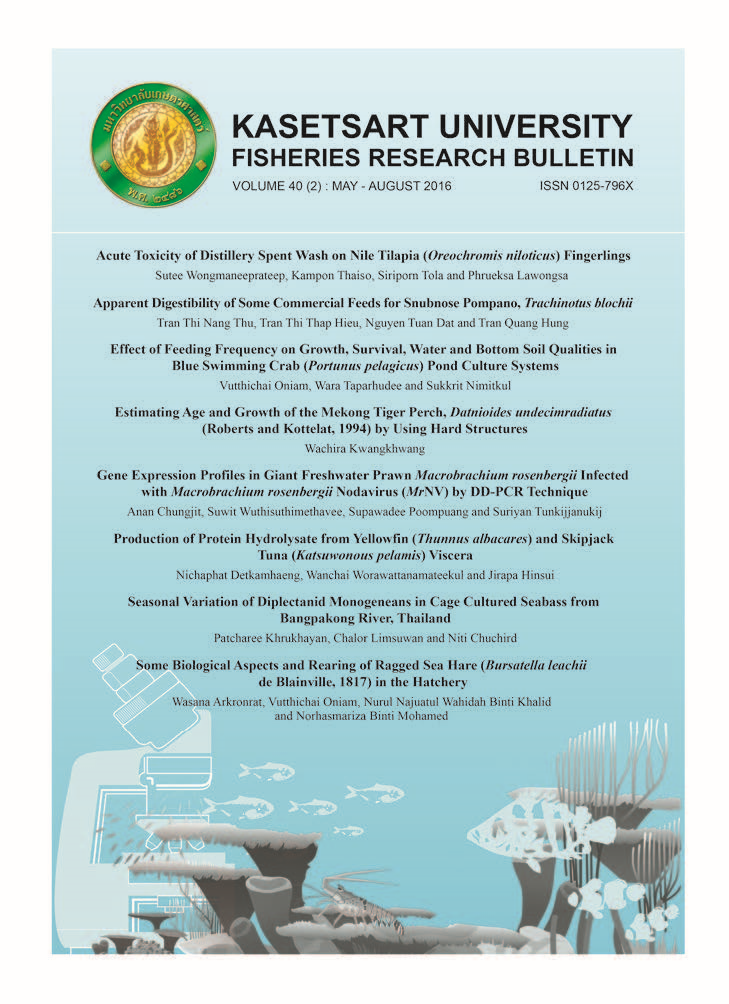Seasonal Variation of Diplectanid Monogeneans in Cage Cultured Seabass from Bangpakong River, Thailand
Main Article Content
Abstract
In this study, monogenean gill parasites in cage cultured seabass (Lates calcarifer) in three farms were investigated between June 2010 to June 2011. The farms (A, B, C) represent the three salinity zones in seabass cage culture in Thailand. Three species of diplectanid monogenean, Laticola lingaoensis, L. paralatesi and Diplectanum penangi, were isolated from 691 seabass. The prevalence values of parasites from the three farms were more than 90%. L. lingaoensis was the most dominant parasite followed by L. paralatesi and D. penangi, respectively. The mean intensity of monogenean parasite species was highest in Farm B which was statistically different (p<0.05) followed by Farm A then Farm C. The prevalence of gill parasites was high in all farms in both dry and rainy seasons. In addition, the mean intensity of gill parasites in Farms A and B showed a high rate of infection during the dry season.
Article Details
References
2. Bush, A.O.; K.H. Lafferty, J.M. Lotz, A.W. Shostak. 1997. Parasitology meets ecology on its own terms: Margolis et al. revisited. J. Parasitology. 83, 575-583
3. Chubb, J.C. 1963. On the characterization of parasite fauna of the fish of Llyn Tegid, Proc. Zool. Soc. London, 141: 609-621.
4. Grey, D.L. 1987. An overview of Lates calcarifer in Australia and Asia, pp. 15-21. In J.W. Copland and D.L. Grey, eds. Management of Wild and Cultured Seabass/Barramundi (Lates calcarifer): Proceedings of an international workshop. 24-30 September 1986. Australian Centre for International Agriculture Research (ACIAR). Darwin, Australia.
5. Hanzelova, V. and R. Zitnan. 1985. Epizotiologic importance of the concurrent monogenean invasion in carp. J. Helminthologia, 22: 277-283.
6. Hopkins, C.A. 1959. Seasonal variations in the incidence and development of cestode Proteocephalus fillicolis (Rud, 1810) In Gasteosteus aculeatus L. I 1766). Parasitology, 49: 529- 542.
7. Kennedy, C.R. 1971. The effect of temperature upon the establishment and survival of the cestode Caryophyllaeus laticeps in Orfe, Leuciscus indus. Parasitology, 63:59-66.
8. Koskivaara, M., E.T. Valtonen and M. Prost. 1991. Dactylogyrids on the gills of roach in central Finland: Features of infection and species composition. Int. Parasitology, 21(5); 565-572.
9. Koyun, M. 2011. Seasonal distribution and ecology of some Dactylogyrus species infecting Alburnus alburnus and Carassius carassius (Osteichthyes: Cyprinidae) from Porsuk River, Turkey. African Journal of Biotechnology, 10(7): 1154-1159.
10. Leong, T.S. and S.Y. Wong. 1990. Parasites of healthy diseased juvenile grouper (Epinephelus malabaricus (Bloch and Schneider)) and Asian seabass (Lates calcarifer (Bloch)) in floating cages in Penang, Malaysia. Asian Fisheries Science, 3:319-327.
11. Leong, T.S. and A. Colorni. 2006. Infectious diseases of warmwater fish in marine and brackish waters. In: Woo, P.T.K., Bruno, D.W. and Lim, L.H.S. (eds), Diseases and Disorders of Finfish in Cage Culture. CAB International 2002. pp. 193-230.
12. Leong, T.S., T. Zilong and J.E. William. 2006. Important parasitic diseases in cultured marine fish in the Asia Pacific Region. Featured articles. In: http://www.thefishsite.com
13. Liang, KS. and T.S.Leong.1991.A redescription of Pseudorhabdosynochus latesi (Tripathi, 1955) and description of Diplectanum penangi n. sp. (Monogenea: Diplectanidae) from Lates calcarifer cultured in floating cages in Malaysia and Thailand. Journal of Bioscience, 2(1&2):77-84.
14. Manter, H.W. 1966. Parasites of fishes as biological indicators of recent and ancient conditions. In: Host parasite relationships, McCauley, J.E. (Ed.). Oregon state University Press, USA. pp: 59-71.
15. Muralidhar, A. 1989. Seasonal variation of helminth parasites in marine fishes at East coast of India. Ind. J. Helminthol, 41: 1-4.
16. Rodrigues, A.A. and A. Saraiva. 1996. Spatial distribution and seasonality of Pseudodactylogyrus anguillae and P. bini (Monogenea) on the gills of the European eel Anguilla Anguilla from Portugal. Bull of the European Association of Fish Pathologists, 63(3): 85-88.
17. Rohde, K. 1993. "Ecology of marine parasites" An introduction to marine parasitology. Department of Zoology, Unit of New England, Armidale, NSW, 2351, Australia. CAB International.
18. Tuner, E.T. 2000. Seasonality of Alloglossoides cardicola (trematoda: Macroderiodea) infection in the cray fish, Procambarus acutus. South western Naturalist, 45(1): 69-71.
19. Wang, G.T., W.J. Yao and P. Nie. 2001. Seasonal occurrence of Dollfustrema vaneyi (Digenea: Buccephalidae) metaceraria in the bull head catfish Pseudobagnus fluvidraeo in a reservoir in China. Disease of Aquatic Organisms, 44(2): 127-131.
20. Yamaguti, S. 1963. Systema Helminthum, Vol. IV. Monogenea and Aspidocotylea. Interscience publishers, a division of John Wiley & Sons, New York and London.
21. Yang, T., D.C. Kritsky, D.C., Y. Sun, J. Zhang, S. Shi and N. Agrawal. 2006. Diplectanids infesting the gills of the barramundi Lates calcarifer (Bloch) (Perciformes: Centropomidae ), with the proposal of Laticola n.g. (Monogenoidea: Diplectanidae). Systematic Parasitology,63:127-141.
22. Yufa, L., C.L. Brown and T. Yang. 2010. Seasonal dynamics of Diplectanum grouperi parasitism on wild versus culture groupers, Epinephelus sp., and the linkage between infestation and host species phylogeny. J. Parasitol, 96(3): 541-546.

